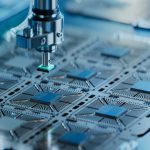CEO Today speaks with Frans Scheper, President & General Manager EMEA at Intel Corporation.
How is Intel’s manufacturing strategy presently helping to balance and diversify the global supply chain of semiconductors?
Semiconductor chips are seen as “the new oil”, given how integral they are to the devices that power our daily lives. But as demand has grown, chip supply has tightened – exposing fragilities in the silicon supply chain, and the fallout from the pandemic is still causing ripple effects that are likely to continue for a few more years.
Historically speaking, the semiconductor industry has been more vulnerable to disruption than most – just this year in March a 90-minute power outage in a small area of Taiwan impacted 10% of the world’s dynamic random-access memory (DRAM) supply. And who can forget the dramatic blockage of the Suez Canal last year, and the chaos that caused for supply chains across the world?
All of that said, the challenges we face today are far from new – many are deeply rooted in the industry but have been exacerbated by the events of recent years. Even so, balancing and diversifying a sector of this scale requires industry players and governments across the world to act collectively now. Inevitably, it will also take some time.
Intel’s strategy focuses on strengthening the global supply chain in the long term, but the ball is already rolling on this. We’re actively investing and building capabilities in various parts of the world. In turn, we hope to address the difficulties that can come with an industry being geographically condensed in a particular region.
So, in addition to building fabs across the pond, we’re also developing facilities closer to home in Europe. That’s particularly important to me because Europe is very much a part of Intel’s heritage. Since our first European office opened in the UK nearly 50 years ago, we have continuously grown our presence and investment in the region.
Today, Intel remains firm in its mission to make a “one-in-a-generation” investment in Europe as part of its IDM 2.0 strategy. And we’ve already seen these investments begin to come to life across the region. For example, earlier this year in March Intel announced its €33 billion investment for R&D and manufacturing across the EU, with plans to invest as much as €80 billion in the EU over the next decade.
These sites would bring more than manufacturing, they will also generate innovation: the new fab in Germany is expected to deliver chips using Intel’s most advanced, Angstrom-era transistor technologies, serving the needs of both foundry customers and Intel for Europe and globally as part of IDM 2.0.
We’ve also recently announced our plans for a microchip design laboratory in Barcelona, a key investment for the future of Spain’s economy. Beyond generating technology and attracting highly qualified talent in Barcelona, the arrival of a centre of this magnitude in Spain will contribute to reducing foreign dependence on microchips, key technological elements for the future of the industry. There are also further investments planned in Ireland, France, and Poland. And with the arrival of the European Chips Act and the Digital Decade targets, it’s clear to me that our region’s leadership is as ready as we are to re-build a thriving, state-of-the-art and regional semiconductor supply chain.
All of this will contribute to the EU’s goal to increase the semiconductor production share from 9% today to 20% by 2030, helping to increase supply chain resiliency in the whole of EMEA and arguably the world.
Why must the European region look to a diverse talent pool to bring its digital supply vision to life?
Simply put, all the vision and innovation in the world mean little if we lack the talent and the skills to execute it. The ongoing shortage of technical skills, or the lack of female representation in STEM-related fields, will hold the region’s digital supply vision back.
As such, in order to secure a viable future for Europe’s digital vision we need to think on the front foot – and this is especially true when it comes to talent. Luckily, EMEA is one of the most diverse regions in the world. Across 115 nations, EMEA boasts a talent pool that can drive innovation across manufacturing, R&D, design, software development, and more.
As we look to diversify the global supply chain, tech companies must recognise the region’s potential to usher in the next era of technological advancements. And an unwavering commitment to D&I will help us get there.
Initiatives to attract university students are certainly a great help, but working with even younger pupils and incorporating AI into the education system can also help boost digital readiness, future-proof EMEA’s workforce and encourage people from more diverse backgrounds to consider a career in the field.
What opportunities does EMEA have to advance digital society and support green transition via the development of semiconductors?
It’s no secret that the industry has a high entry cost. Semiconductor projects face significant cost disadvantages in Europe compared to many attractive locations in the rest of the world. It can cost 40 to 50% more to operate a fab in Europe compared to Asian countries, for example.
However, EMEA has a historical connection to the industry, and our efforts to revive it provide opportunities to build a greener, more sustainable semiconductor sector that benefits people and the planet. Semiconductor chips are the foundation of the digital age, and we have a serious responsibility to make sure this critical industry does not hinder the equally critical green transition. After all, it’s also no secret that the industry can be resource and energy-intensive too.
Collaboration with the public sector is one of the opportunities we’re exploring. Not only are partnerships with the public sector necessary to level the playing field, but they also provide a platform for an exchange of skills and best practices that can help us all progress in the green transition.
However, to make this happen, efforts to reignite Europe’s chip industry must be coupled with serious commitments to sustainability and minimising the impact on the environment. Developing ways to conserve, recycle and reclaim water is one option for achieving this. Partnering with local water projects to restore more fresh water than is being used to achieve water net positive usage is another. In addition, powering manufacturing operations with 100% renewable energy and sending zero total waste to landfills also helps.
That said, no single company can change an industry alone. Working with suppliers big and small all over the world can help companies in EMEA encourage positive change across the entire supply chain, and help the industry become more environmentally friendly.
What are your future predictions for the automotive industry?
The automotive industry is in the midst of unprecedented change. The sector has accelerated toward widespread electrification and electric vehicle adoption, and traditional auto brands are under pressure to evolve their sustainability practices and even re-evaluate the best ways to sell vehicles.
This has led to companies that have spent decades perfecting the production of vehicles, reinventing themselves and going from “car makers” to mobility services providers in favour of environmental sustainability.
I suspect this trend will continue. Data analytics, AI, the cloud, and in-vehicle compute advancements will become the key to making driving an experience rather than just a method of transport.
The car will quickly become just one part of a broader mobility ecosystem as car companies look to develop and execute increasingly futuristic visions of the in-vehicle experience - from seamless rapid charging for electric vehicles to intelligent driverless cars.
In turn, we’ll see growing numbers of retailers and automakers look to capitalise on tech solutions that enhance that in-vehicle experience for drivers and passengers alike. As a result, upgradeability will be key. Given the increasing speed of innovation in software-based systems, consumers will require cars that can evolve alongside technological advances.











